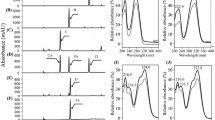Abstract.
Stable-isotope-labelled (2H6,18O) 3-hydroxy-3-phenylpropanoic acid, a putative intermediate in the biosynthesis of benzoic acid (BA) and salicylic acid (SA) from cinnamic acid, has been synthesized and administered to cucumber (Cucumis sativus L.) and Nicotiana attenuata (Torrey). Analysis of the products by gas chromatography-mass spectrometry revealed incorporation of labelling into BA and SA, but not into benzaldehyde. In a separate experiment, 3-hydroxy- 3-phenylpropanoic acid was found to be a metabolite of phenylalanine, itself the primary metabolic precursor of BA and SA. These data suggest that cinnamic acid chain shortening is probably achieved by β-oxidation, and that the proposed “non-oxidative” pathway of side-chain degradation does not function in the biosynthesis of BA and SA, in cucumber and N. attenuata.
Similar content being viewed by others
Author information
Authors and Affiliations
Additional information
Received: 10 February 2000 / Accepted: 18 April 2000
Rights and permissions
About this article
Cite this article
Jarvis, A., Schaaf, O. & Oldham, N. 3-Hydroxy-3-phenylpropanoic acid is an intermediate in the biosynthesis of benzoic acid and salicylic acid but benzaldehyde is not. Planta 212, 119–126 (2000). https://doi.org/10.1007/s004250000377
Issue Date:
DOI: https://doi.org/10.1007/s004250000377




